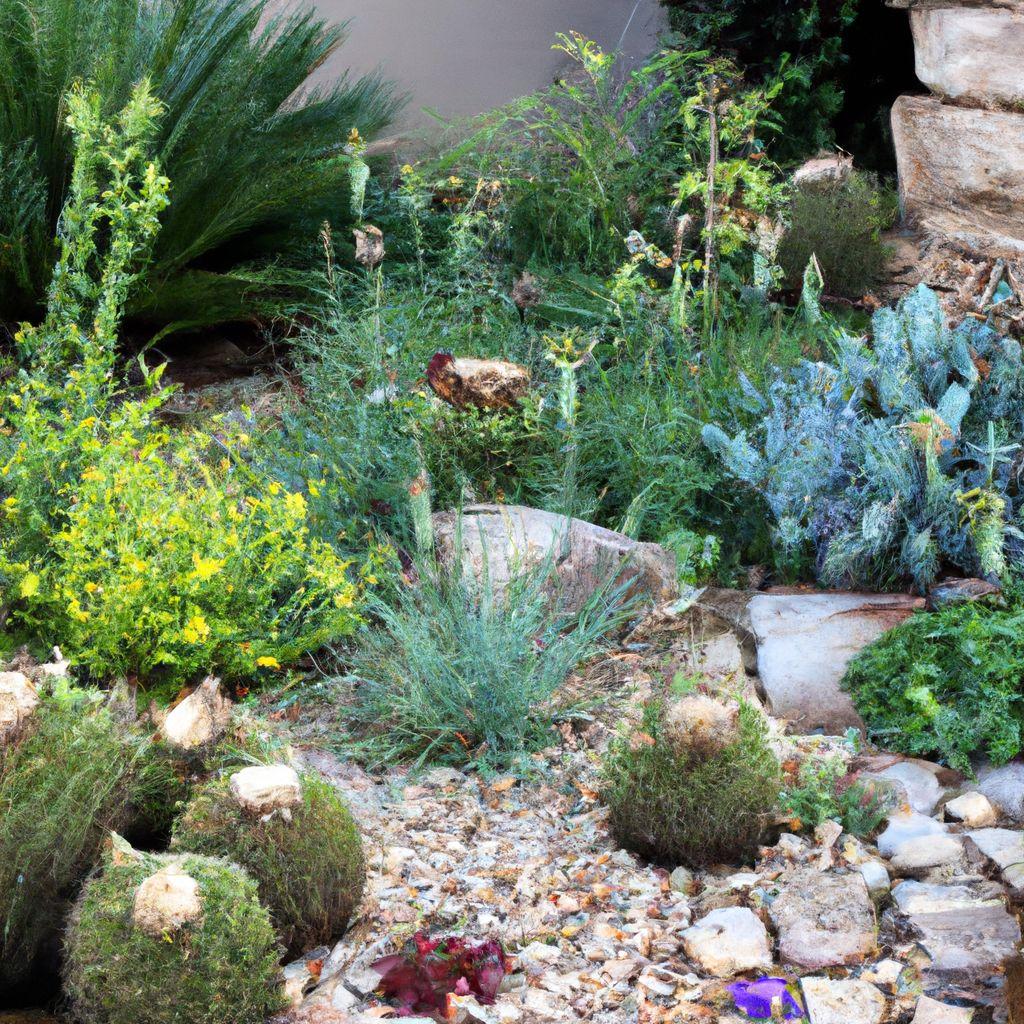Key takeaway:
- Xeriscaping with cacti and succulents is a sustainable landscaping solution that offers several benefits.
- Common misconceptions about xeriscaping can be overcome with the understanding of the variety of plants available for xeriscaping.
- When planning a xeriscape garden, it is important to assess your garden’s needs and microclimate and use cacti and succulents in the design.
- Choosing the right plants for your climate involves understanding hardiness zones and soil types and selecting suitable succulents and cacti for your xeriscape garden.
- Consideration of sunlight and proper placement is crucial for the success of cacti and succulents in a xeriscape garden.
- Mulching and other water-saving techniques play a significant role in conserving water in a xeriscape garden.
- Incorporating native and non-native plants, companion plants, and purchasing plants responsibly are important aspects of a well-designed and sustainable xeriscape garden.
Introduction: Xeriscaping with Cacti and Succulents – A Sustainable Landscaping Solution
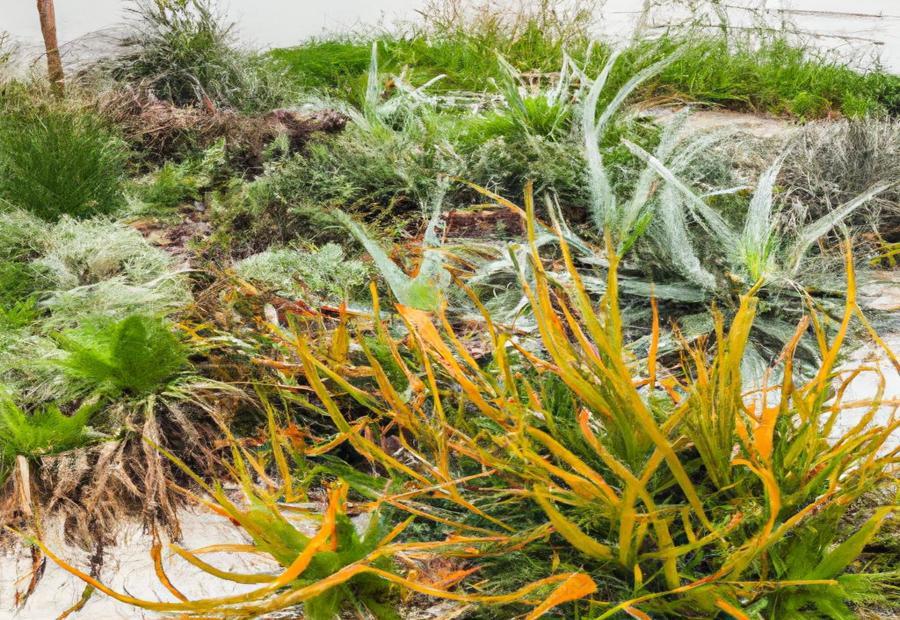
Photo Credits: Gardeninggurus.Org by George Martin
Xeriscaping with cacti and succulents is not only a sustainable landscaping solution but also a smart choice for conserving water and maintaining a beautiful outdoor space. In this section, we will explore the benefits of xeriscaping with cacti and succulents, debunk common misconceptions, and provide you with valuable insights on how to create a thriving and low-maintenance landscape using these resilient plants. Get ready to embrace the beauty and efficiency of xeriscaping!
The Benefits of Xeriscaping with Cacti and Succulents
Cacti and succulents are the perfect way to xeriscape – they require minimal water and maintenance, and offer numerous other benefits! Water conservation? Check. Drought resistance? Yep. Low maintenance? You bet. Plus, with their diverse aesthetics and eco-friendly approach, xeriscaping with cacti and succulents can help create a sustainable landscape that’s unique and oh-so-trendy! Remember to research and select varieties that are best suited to your local climate and soil conditions before getting started.
Common Misconceptions about Xeriscaping
Xeriscaping with cacti and succulents is an eco-friendly garden solution. But, there are misconceptions about it that need clearing up.
One is that it needs a desert-like landscape. Cacti and succulents are often linked to dry areas, but they can survive in various climates and soils. So, you can xeriscape anywhere with the right planning and plants.
Another misconception is that a xeriscaped garden is ugly. Wrong! The shapes, colors, and textures of cacti and succulents give them a unique beauty. They can make a garden look amazing.
Many think xeriscaped gardens don’t need care. This isn’t true. They need less water and maintenance than regular gardens, but still require weeding, pruning, and monitoring.
Understanding these misconceptions can help you plan an amazing xeriscaped garden. Debunk the myths and turn your garden into a gorgeous and sustainable oasis. So, get ready to succulent your way through a garden of prickly beauty!
Exploring the Variety of Xeriscaping Plants
Xeriscaping, a water-efficient landscaping technique, offers a diverse range of plant options. In this section, we will explore the variety of plants suitable for xeriscaping. From native plants that are well adapted to the local climate to non-native species that can thrive with minimal watering, each sub-section will highlight the unique characteristics and benefits of these xeriscaping plants.
Native Plants for Xeriscaping
Xeriscaping with native plants grants many benefits for a sustainable and water-conserving garden. These plants are suited to the local climate and require little maintenance. They can survive in arid conditions, cutting down on the need for irrigation – making them ideal for xeriscaping projects.
Native plants for xeriscaping:
- Naturally adjust to the region’s environment, conserving water.
- Deep root systems access groundwater, eliminating the need for extra watering.
- Provide food and shelter for wildlife, increasing biodiversity.
- Require little use of fertilizers and pesticides as they are accustomed to local soil types and pests.
- Coexist with local insects, building a balanced ecosystem that supports pollination and natural pest control.
- Keep the distinctiveness of a region’s flora.
Including native plants in xeriscaping conserves water and promotes ecological sustainability. These plants fit the climatic conditions, sustaining balance between the landscape design and its surroundings. Selecting native species for xeriscaping produces gardens that blend into nature, while still being aesthetically pleasing.
Non-Native Plants for Xeriscaping
Cacti and succulents are perfect for xeriscaping because they thrive in arid conditions. But non-native plants can also be included in xeriscape gardens. Here are 3 things to consider when selecting them:
- Adaptability: Choose plants that suit local climate and soil. They may need more water than native ones, but still help conserve it.
- Aesthetics: Non-native plants bring unique beauty and colors. Pick ones that match existing landscaping for an eye-catching look.
- Biodiversity: Non-native plants boost biodiversity by providing habitat to different species. This adds ecological value and creates a dynamic ecosystem.
For a successful xeriscape garden, research plants’ requirements like sunlight and soil type. Select the right species and give them the best conditions. This enhances sustainability and visual appeal.
Mix native and non-native plants in your xeriscape garden! They provide unique benefits and help conserve water. Start exploring non-native plants for xeriscaping today!
Planning Your Xeriscape Garden
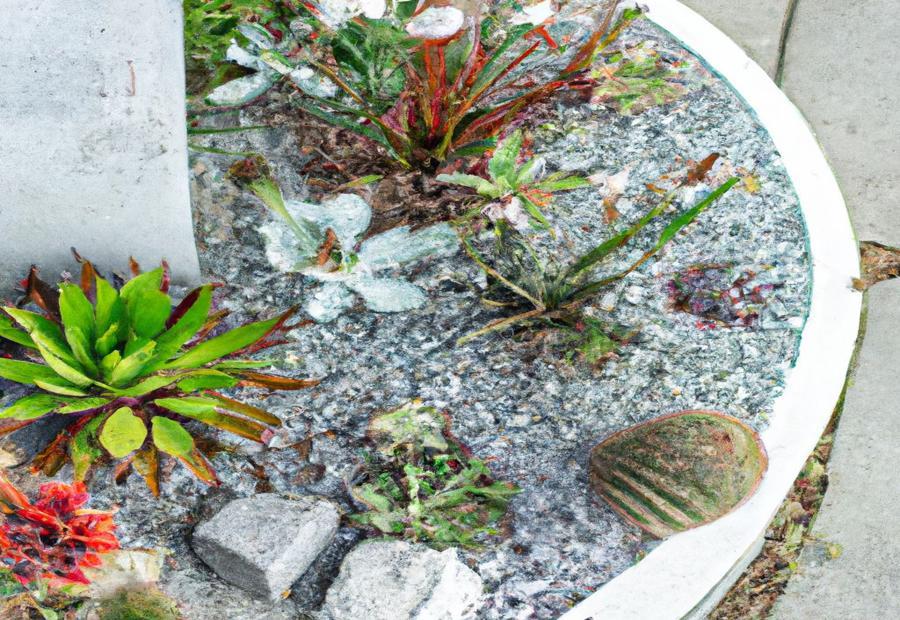
Photo Credits: Gardeninggurus.Org by Dylan Moore
When creating your xeriscape garden, it’s essential to start by assessing your garden’s needs and microclimate. This sub-section will provide valuable insights into tailoring your xeriscape garden to thrive in your specific environment. Additionally, we’ll explore the art of designing a xeriscape garden with cacti and succulents, offering practical tips and ideas to create a stunning landscape that conserves water and showcases the beauty of these resilient plants.
Assessing Your Garden’s Needs and Microclimate
Analyzing your garden’s specific requirements and microclimate is crucial for xeriscaping with cacti and succulents. Knowing the plant’s exact needs and environmental conditions enables you to create a sustainable and flourishing xeriscape.
- Examine water needs: Evaluate the soil type, drainage capability, and water retention ability to figure out the water requirements. This will help you pick drought-resistant plants that can flourish in low-water environments.
- Check sunlight exposure: Figure out the amount of sunlight different parts of your garden get each day. This data will help you decide where to place sun-loving cacti and succulents, giving them adequate light for growth.
- Look at temperature changes: Look into temperature patterns in your garden, including daily highs and lows. This understanding will guide you in selecting plants that can endure climate variations.
- Understand wind and shade: Note any prevailing winds or shade sources in your garden. This evaluation will help you position cacti and succulents properly, protecting them from strong winds or providing them reprieve from too much heat.
Incorporating these thoughts into assessing your garden’s needs and microclimate lets you make wise decisions during the xeriscape planning process. Taking these matters into account ensures that the chosen plants are suitable for their surroundings, promoting a healthy and vivid xeriscape garden.
Pro Tip: When examining your garden’s microclimate, think about creating microclimates within it by using techniques like adding windbreaks or placing plants strategically for shade. These measures can aid in creating beneficial conditions for particular cacti and succulent types, enhancing their growth and well-being.
Designing a Xeriscape Garden with Cacti and Succulents
Text: Design a Xeriscape Garden with Cacti and Succulents!
Include a variety of native and non-native plants for a unique design.
Be mindful of the microclimate and soil type for successful growth.
Place these plants in sunny areas for maximum benefits.
Mulching and water-saving practices promote sustainability.
Mix companion plants to add beauty while maintaining sustainability.
Purchase responsibly to protect species and conserve resources.
Follow these guidelines to make a stunning, sustainable xeriscape garden with cacti and succulents!
Choosing the Right Plants for Your Climate

Photo Credits: Gardeninggurus.Org by Austin Davis
When it comes to xeriscaping with cacti and succulents, a crucial consideration is choosing the right plants that can thrive in your specific climate. This section explores the factors of understanding hardiness zones and soil types, as well as the art of selecting and grouping succulents and cacti for a stunning xeriscape garden. With this knowledge, you can ensure the success of your garden by aligning your plant choices with the conditions of your local climate.
Understanding Hardiness Zones and Soil Types
Understanding hardiness zones and soil types is key when planning a xeriscape garden. Hardiness zones show the minimum temperature for plants to survive. This helps to make sure the chosen plants can handle the climate.
Different succulents and cacti also have varying soil requirements. For instance, some need well-drained soil while others prefer sandy or loamy soil. Knowing this info assists in selecting plants that will grow well. It also helps to reduce water use and maintenance in a sustainable xeriscape garden.
Selection of Succulents and Cacti Grouping for Xeriscape Garden
Choosing succulents and cacti is essential when crafting a xeriscape garden. These plants can store water in their roots, stems, and leaves, making them perfect for water-efficient landscaping. By picking the right succulents and organizing them properly, you can design a beautiful and sustainable xeriscape garden.
For selecting succulents and cacti for a xeriscape garden, here is a helpful table:
| Plant Name | Water Requirement | Sun Exposure | Height (inches) |
|---|---|---|---|
| Aloe Vera | Low | Full sun | 12-24 |
| Agave | Low | Full sun | 24-96 |
| Sedum | Low | Partial sun | 6-18 |
These succulents have low water needs and prefer full or partial sun. This means they’re great for a xeriscape garden. Plus, they come in different heights. So, you can create different designs on the ground or use taller succulents as focal points.
To make your xeriscape garden even more impressive, consider adding some extra features. Plant cascading succulents like Echeveria along slopes or walls. Also, combine agaves with grasses or flowering perennials for interesting contrasts. Vary the sizes and shapes of the plants to give your xeriscape garden depth and intrigue.
By selecting the best succulents and arranging them artfully, you can make a stunning and water-conserving xeriscape garden that’s well-suited to your climate and soil. Vampires will have no chance of finding shade when they see these cacti and succulents in a xeriscape garden!
Considering Sunlight and Placement
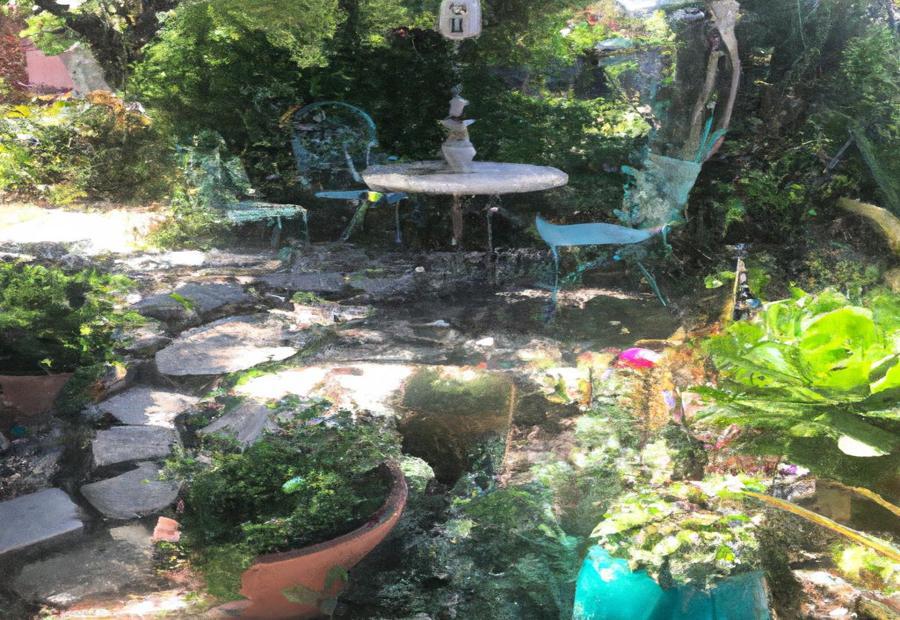
Photo Credits: Gardeninggurus.Org by Bruce Gonzalez
Understanding how sunlight and placement play a vital role in the success of xeriscaping with cacti and succulents, we will explore the importance of sun exposure and the optimal placement of these plants in a xeriscape garden. By delving into these key aspects, we can ensure the thriving growth and sustainability of our desert-inspired landscapes.
Understanding the Importance of Sun Exposure
It’s vital to comprehend the importance of sun exposure for the growth and overall health of plants. Sunlight plays an enormous role in a plant’s development, like photosynthesis, flower production, and foliage lifespan. Especially for creating a successful xeriscape garden with cacti and succulents.
Plants use sunlight as energy through photosynthesis. Chlorophyll in their leaves absorbs the sunlight, converting it into chemical energy that fuels their growth. Different plants have various sun exposure needs – some love direct sunlight, while others prefer partial shade or indirect light. Cacti and succulents are known for being hardy and adaptable to various light situations, yet it’s still critical to give them the right amount and intensity of sunlight.
Understanding the importance of sun exposure requires considering many factors, such as the duration and intensity of sunlight in your region. Regions can differ in their levels of sunlight – some with intense sunlight for long periods and others with shorter days or more cloud cover. These differences can affect plant growth and productivity significantly. Plus, some cacti and succulents may need certain levels of light exposure to bloom or keep their shapes.
By recognizing the significance of sun exposure, you can strategically place your cacti and succulents in your xeriscape garden. Examine your garden’s microclimate to identify areas with varied levels of sunlight throughout the day. This knowledge will enable you to position your plants according to their light requirements while maximizing their looks within the overall design.
Find the perfect spot for your prickly pals in your xeriscape garden and watch them flourish in their natural habitat, all by understanding the importance of sun exposure.
Placement of Cacti and Succulents in a Xeriscape Garden
Creating an attractive and sustainable xeriscape garden requires careful placement of cacti and succulents. These plants are known for surviving in dry climates, making them great for water-efficient gardens. To do this, you need to consider sunlight exposure, soil types, and hardiness zones.
Cacti and succulents need lots of sun, so pick spots that don’t get any shade. Avoid spots with partial shade from tall plants or structures.
Soil type is also important. These plants prefer soils that drain easily, like sandy or gravelly soil. Too much moisture can lead to root rot.
It’s also essential to know your hardiness zone. Different varieties have different levels of cold tolerance. This lets you know if winter protection is needed.
By considering the above factors, you can create a visually pleasing landscape while conserving water. Onward to the next step – mulching and other water-saving techniques!
Mulching and Other Water-Saving Techniques
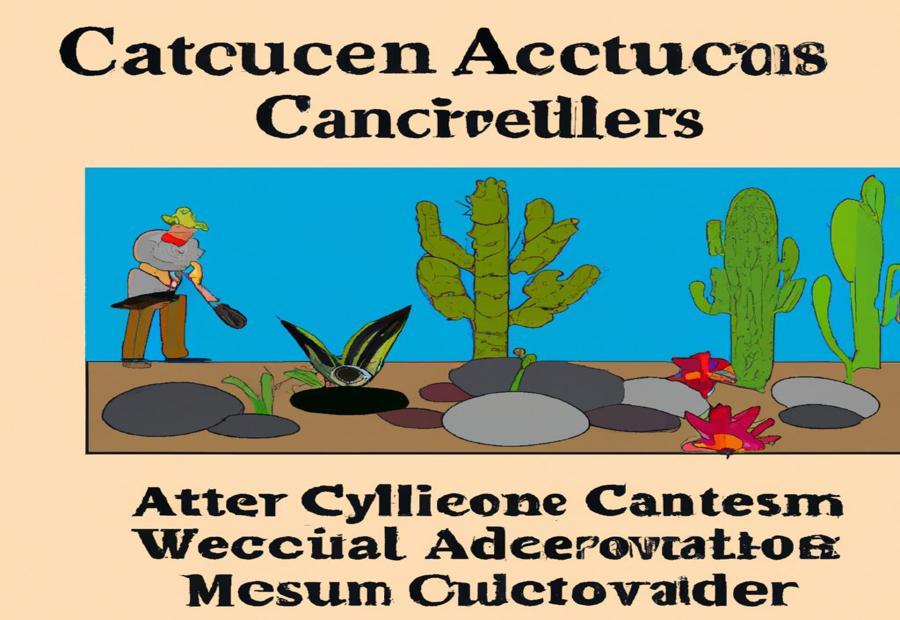
Photo Credits: Gardeninggurus.Org by Michael Rodriguez
Mulching not only conserves water but also enriches the soil. In this section, we’ll explore various types of mulch suitable for xeriscaping, along with effective water-saving techniques for your xeriscape garden. So, whether you’re looking to reduce water usage or improve soil retention, read on to discover practical tips and options that will maximize the benefits of xeriscaping with cacti and succulents.
Types of Mulch for Xeriscaping
Mulching is a key part of xeriscaping. It helps keep water, maintain soil moisture, suppress weeds and regulate temperatures. Here’s a look at the various mulch types for xeriscaping with cacti and succulents.
- Organic Mulch: This includes materials like wood chips, straw, bark, or compost. Organic mulches retain moisture and add nutrients to the soil as they break down. They also form a protective layer over the soil, preventing evaporation and weed growth.
- Gravel or Rock Mulch: Gravel or rock mulches are great for xeriscaping as they are durable and low maintenance. They prevent erosion and let water seep into the soil. Plus, these mulches absorb heat during the day and release it at night, which insulates plants.
- Rubber Mulch: Made from recycled tires, rubber mulch is an eco-friendly option with excellent water retention properties. It regulates soil temperature and stops weed growth. It is a long-lasting alternative to other mulches.
Selecting the right mulch for your xeriscape is essential. Think about local availability, climate, looks and maintenance. Each mulch has its own pros and cons.
Organic mulches can attract pests or create fungal growth if not managed well. Gravel or rock mulches need occasional cleaning or leveling. Rubber mulch may release chemicals into the soil, but this is usually harmless for plants.
Pick the right mulch to maximize water efficiency, stop weed growth and get a stunning landscape with cacti and succulents. Enjoy a drought-proof paradise – every drop counts.
Water-Saving Techniques for Xeriscape Garden
Water conservation is key for xeriscape gardening. Especially when growing cacti and succulents that need little irrigation. Applying effective water-saving techniques will help maintain a sustainable garden while reducing water usage.
- Select drought-tolerant plants. Pick native and non-native plants that are adapted to arid weather. Succulents and cacti, with their water-storing ability, are great choices.
- Group plants with similar watering needs. This helps prevent overwatering or underwatering certain areas.
- Install efficient irrigation systems. Drip or micro-sprinklers deliver water directly to the roots. Use timers or moisture sensors to optimize watering schedules.
- Put mulch around plants. This helps conserve moisture, control soil temperature, and prevent erosion.
- Practice proper watering techniques. Water deeply, but infrequently. Do it early in the morning or late in the evening to minimize evaporation.
Not only do these techniques save water, they also promote healthier plants, boost soil fertility, and prevent water-related issues.
Xeriscape gardening is an eco-friendly way to enjoy a beautiful garden while conserving water. With conscious decisions about plants, irrigation, and maintenance, you can have a water-saving masterpiece, complete with cacti and succulents!
Incorporating Cacti and Succulents in a Xeriscape Design
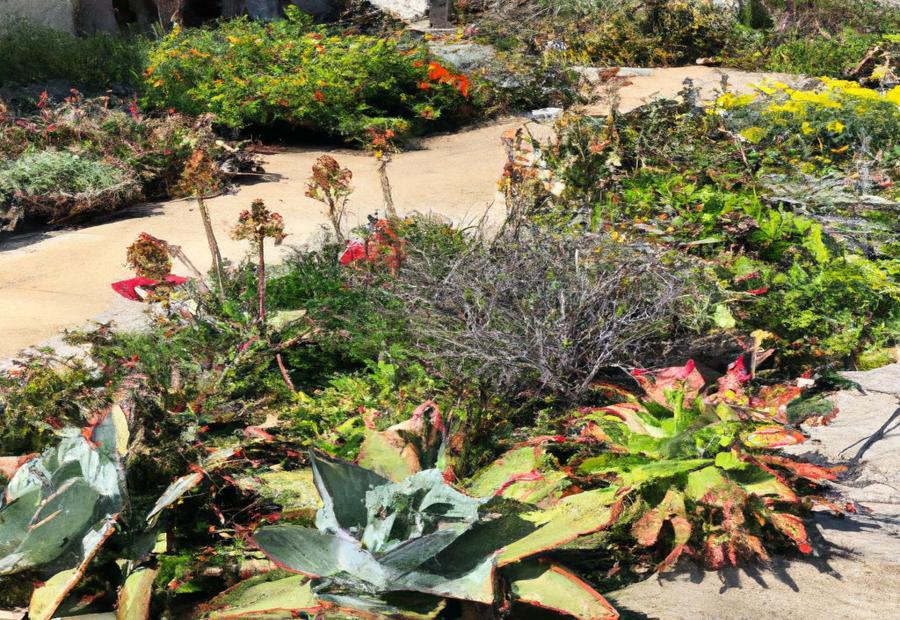
Photo Credits: Gardeninggurus.Org by Logan Ramirez
Incorporating cacti and succulents in a xeriscape design is a clever and sustainable landscaping choice. Discover the significance of using native and non-native plants, explore companion plants for cacti and succulents, and learn about responsible plant purchasing and species conservation. Let’s dive into how these elements come together to create a beautiful and water-efficient xeriscape garden.
The Importance of Native and Non-Native Plants
Native and non-native plants are vital for xeriscaping with cacti and succulents. Incorporating native plants, which are local to the ecosystem, helps preserve the natural biodiversity of an area. These plants thrive in the climate, soil conditions, and wildlife interactions, needing less maintenance. Non-native plants bring diversity, aesthetics, and extra habitat possibilities to xeriscape gardens.
Native plants have many advantages. They usually require less water, tolerant of drought, and provide food and shelter for wildlife like birds, butterflies, and pollinators. They also contribute to soil health, promoting nutrient cycling and preventing erosion.
Non-native plants contrast native plants with their colors, form, texture, and flowering patterns. They can be focal points or visual accents in the garden design. But, it is important to pick suitable non-native plants that won’t become invasive. Invasive non-native species can overpower native plants and disturb the balance of the ecosystem.
To ensure responsible gardening with both native and non-native plants, purchase from reliable nurseries that don’t collect wild specimens or propagate invasive species. Supporting local nurseries and buying cultivated varieties instead of wild-harvested ones promotes biodiversity conservation, as well as enjoying the beauty of cacti and succulents.
Companion Plants for Cacti and Succulents
Companion planting is the practice of placing different species close together, to benefit each other. Cacti and succulents need specific companion plants to help them grow and stay healthy. These plants can offer beauty, shade, useful insects, and water conservation.
- 1. Drought-Tolerant Flowers: Lavender, agastache, and yarrow can form a stunning garden when planted with cacti and succulents. These flowers not only look great, but also bring pollinators vital for desert plant reproduction.
- 2. Grasses: Feather grass or blue fescue bring contrast to the desert plants and offer shade and wind protection. They also help keep the ground stable and reduce soil erosion.
- 3. Ground Cover Plants: Sedum or creeping thyme make great companions for cacti and succulents. These plants spread out over the ground, suppressing weeds and keeping moisture in the soil.
When choosing companion plants for cacti and succulents, consider their water needs and growth habits. This will help you create a sustainable xeriscape garden that brings harmony and beauty to your desert landscape. Plus, you’ll be helping the species – choose your cacti wisely!
Purchasing Plants Responsibly and Conserving Species
For a sustainable xeriscape garden with cacti and succulents, purchasing plants responsively and preserving species is key. So, be informed when selecting plants and consider their environmental impact and native species conservation.
For responsible plant purchasing, choose locally sourced and propagated plants. Native plants are best, as they can survive the climate and need less maintenance. Plus, they give food and habitat to local ecosystems and wildlife.
Non-native plants can also be included, but be careful to select non-invasive ones that won’t harm native species. Research and choose non-native plants that have been successful in the local area.
When buying plants, buy from trusted nurseries that source plants legally and don’t take them from the wild. That way, we can help conserve species in their natural habitats.
Conclusion: Creating a Beautiful and Sustainable Xeriscape Garden with Cacti and Succulents
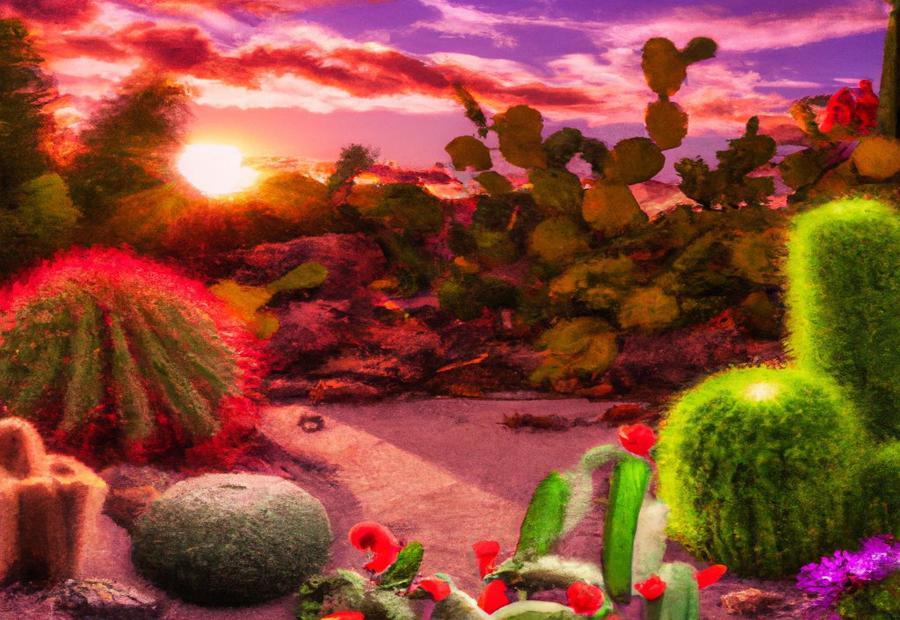
Photo Credits: Gardeninggurus.Org by Thomas Baker
Creating a sustainable, beautiful xeriscape garden with cacti and succulents is a great option. These plants can store water in their stems and leaves. So, they don’t need lots of irrigation. Plus, there’s a wide range of shapes, sizes, and colors to choose from. This adds visual interest to the garden.
Cacti and succulents also thrive in poor soil conditions. They have shallow root systems that extract available nutrients. That means they are good for gardens with sandy or rocky soils.
Some Facts About Xeriscaping With Cacti And Succulents:
- ✅ Xeriscaping is a style of landscaping that aims to use minimal water, making it ideal for areas with low rainfall or high irrigation costs. (Source: Team Research)
- ✅ Cacti and succulents are well-suited for xeriscaping as they are drought-tolerant and able to thrive in arid climates. (Source: Pinterest)
- ✅ Xeriscaping with cacti and succulents can create visually appealing landscapes with a variety of colors and textures. (Source: Lawnandlandscape.com)
- ✅ Proper soil preparation, including adding organic matter like compost, can help improve water-holding capacity and drainage for xeriscaping with cacti and succulents. (Source: Backbone Valley Nursery)
- ✅ Xeriscaping with cacti and succulents is not limited to using only cacti; it can also incorporate other drought-tolerant plants, native shrubs, and ornamental grasses. (Source: High Country Gardens)
FAQs about Xeriscaping With Cacti And Succulents
FAQ 1: What are some examples of xeriscaping plants that can be used in arid environments?
Answer: Some examples of xeriscaping plants that can be used in arid environments include Mexican Blue Fan Palms, Yucca Rostrata, Agaves, Aloe, Prickly Pear Cactus, and various types of succulents.
FAQ 2: What are the three basic divisions in a xeriscape landscape?
Answer: The three basic divisions in a xeriscape landscape are the very low water zone, the low water zone, and the moderate water zone. Each area has specific watering requirements and is irrigated separately.
FAQ 3: How can mulching benefit xeriscaping gardens?
Answer: Mulching can benefit xeriscaping gardens by lowering soil temperature, reducing moisture loss through evaporation, preventing weed growth, and improving water retention in the soil. It is recommended to apply mulch at a depth of 2 to 3 inches for trees and shrubs, and 1 to 2 inches for annuals and perennials.
FAQ 4: What are some factors to consider when incorporating cacti and succulents into landscape design?
Answer: When incorporating cacti and succulents into landscape design, it is important to consider factors such as their specific water needs, the amount of sunlight the garden receives, and their compatibility with other plants. Native plant-focused designs can attract pollinators, while mixing native and non-native cold hardy xeric plants can add variety and color to the landscape.
FAQ 5: How can xeriscaping with cacti and succulents benefit pollinators?
Answer: Xeriscaping with cacti and succulents can benefit pollinators by providing essential early-season nectar sources. Cold-hardy cacti, in particular, attract various types of bees and pollinating wasps, contributing to the overall biodiversity of the garden.
FAQ 6: How can I create a xeriscape garden with succulents?
Answer: To create a xeriscape garden with succulents, start by drafting your plans and selecting the right plants native to your area or known to be drought tolerant. Consider the amount of sunlight your garden receives and use mulch or decorative coverings to retain soil moisture. By following these steps, you can create a beautiful and environmentally friendly garden with succulents.


